The last castle of Scotland
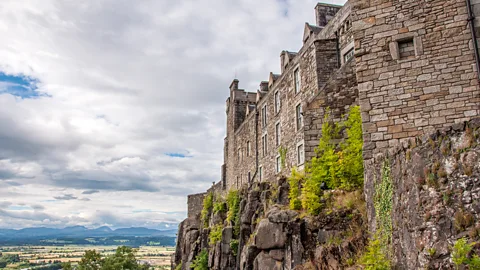 Amanda Ruggeri
Amanda RuggeriStirling Castle isn’t just one of the largest and most famous castles in Scotland. It’s also been one of the most important – and symbolic.
 Amanda Ruggeri
Amanda RuggeriBesieged at least eight times in its history, the castle changed hands many times between the English and Scottish. By the end of the First War of Scottish Independence in 1328, the Scots were able to wrest it back – and Scotland’s King Robert the Bruce ordered the castle’s defences destroyed so that the English couldn’t re-occupy it.
But Stirling Castle’s role in some of Scotland’s most major historical events wasn’t over. In later years, it became a sumptuous residence for Stewart monarchs, including Mary Queen of Scots and King James; and today it’s one of Scotland’s best-known attractions: around a half a million visitors came in 2015, and the fortifications even feature on Scotland’s £20 notes. (Credit: Amanda Ruggeri)
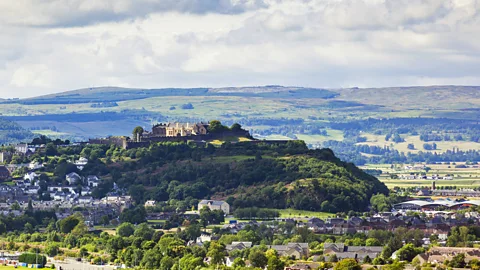 Simon Whaley Landscapes/Alamy
Simon Whaley Landscapes/AlamyAlthough best known for its role in Scottish history, Stirling Castle dates back to before Scotland was a political concept at all. The first fortifications may have been built as early as 3,000 years ago. A local kingdom – perhaps the Celtic Votadini tribe – are thought to have built a hillfort here 2,000 years ago, and tradition holds that the Romans fortified the rock in the 1st Century.
Kenneth MacAlpin, known as the ‘first king of Scotland’, is said to have besieged the castle in the 9th Century. But like tales that Stirling Castle also was the seat of the court of King Arthur, the claims about MacAlpin (who may not even have been Scottish himself) are more myth than fact. (Credit: Simon Whaley Landscapes/Alamy)
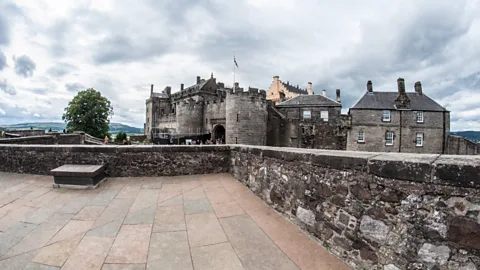 Amanda Ruggeri
Amanda RuggeriWhat we do know is that the castle was associated with Scottish royalty by the Middle Ages.
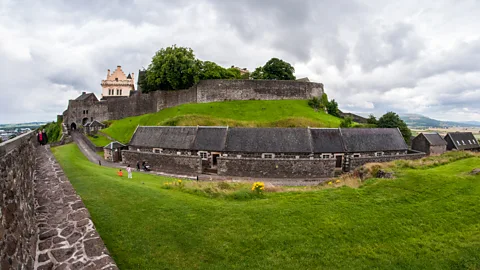 Amanda Ruggeri
Amanda RuggeriRecords from 1110 show that Scotland’s King Alexander I arranged payments for the upkeep of a chapel – a sign that royal links already were established. Around the same time, buildings and courtyards were constructed within the already-old ramparts and earthworks (shown here). The new residences must have been fit for a king, since King Alexander I himself died in the castle in 1124. By the mid-12th Century, the castle had become a key administrative centre. (Credit: Amanda Ruggeri)
 Amanda Ruggeri
Amanda RuggeriEveryone from Celts to Romans to Scottish kings have had an enduring attraction to Stirling Castle, much of it is because of its location.
The craggy peak the castle stands on got its start with a volcanic eruption 350 million years ago. Over ensuing millennia, the lava was buried beneath sandstone and ice. Like much of the rest of Scotland’s dramatic landscape, the rock owes its current shape to the end of the last Ice Age around 10,000 years ago: as the ice sheets retreated, they sculpted the rock into the high perch it is now. (Credit: Amanda Ruggeri)
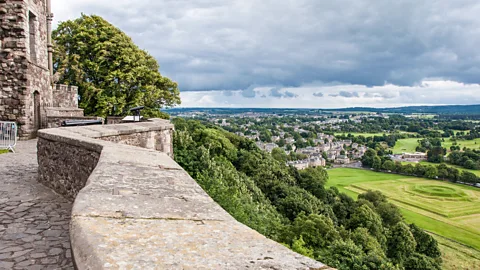
With nearly sheer cliffs on two sides, the rock provides the perfect location for a stronghold.
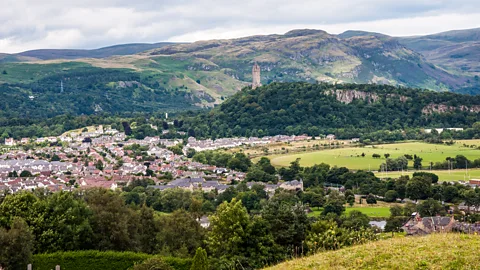 Amanda Ruggeri
Amanda RuggeriThe rock’s spot proved particularly strategic, straddling the intersection between the Highlands to the north and west and the Forth Valley down to Edinburgh to the southeast. Anyone who built a stronghold here would have sight – and control – of the crossroads between the two regions. They’d also be able to watch the much-used bridge over the River Forth, a key crossing point between the Highlands and the south of Scotland. This was a big reason why the castle would play such a key role in various conflicts.
The most famous of these conflicts were the Wars of Scottish Independence. In the late 13th Century, Scotland’s King John was proving less pliable to the English King Edward I’s demands than expected. After the final straw, when the Scottish nobility negotiated a treaty with France against England, Edward invaded and captured Stirling Castle. Led by legendary fighter William Wallace and Andrew Moray, the Scots won the castle back in the famed Battle of Stirling Bridge. This view from Stirling Castle looks across the site of that battle to the National Wallace Monument, the stone tower built in homage to the Scottish war hero.
But their success did not hold out: after a crushing defeat at the Battle of Falkirk, the Scots gave the castle up to the English once more. Scottish forces including Robert the Bruce – later King of Scots – besieged the castle, successfully wresting it back. But by 1303, the tides had turned again: the English now held the upper hand in the conflict, even though they didn't yet hold the castle. (Credit: Amanda Ruggeri)
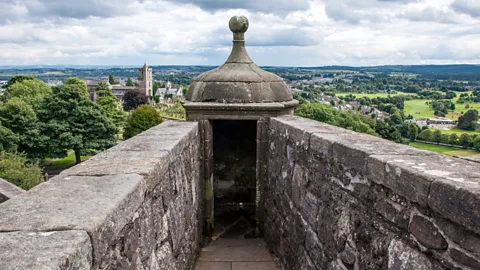 Amanda Ruggeri
Amanda RuggeriBy 1304, Stirling Castle was the last castle still held by the Scots.
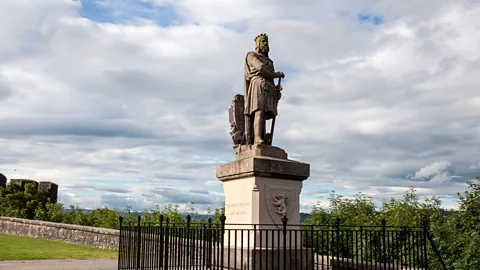 Amanda Ruggeri
Amanda RuggeriThe English king came to crush the remaining Scottish army, conquering the castle once more in 1304. But when Edward died in 1307, Robert the Bruce’s brother besieged Stirling Castle, trying to take it back for good.
When English reinforcements headed north to try to aid the English garrison and secure the castle, they crossed paths with the forces of King Robert the Bruce. That meeting culminated in the famed Battle of Bannockburn of 1314. Pinched on boggy ground between the Bannock Burn and River Forth, the English army was slaughtered. The battle was commemorated in what’s often called the unofficial Scottish national anthem, Flower of Scotland, where the chorus runs:
When will we see
Yer like again – that fought and died for
Yer wee bit Hill and Glen – and stood against him
Proud Edward’s army – and sent him homeward
To think again.
A statue of Robert the Bruce, along with the date of the Battle of Bannockburn – 24 June 1314 – stands as a memorial on castle grounds today. (Credit: Amanda Ruggeri)
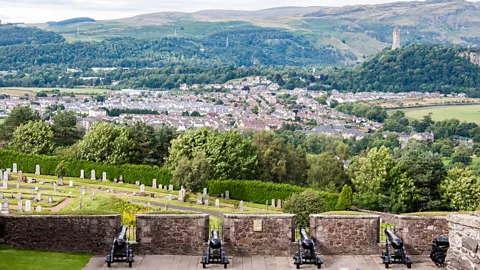 Amanda Ruggeri
Amanda RuggeriFought just outside the castle walls, the Battle of Bannockburn was the most important military victory in Scottish history.
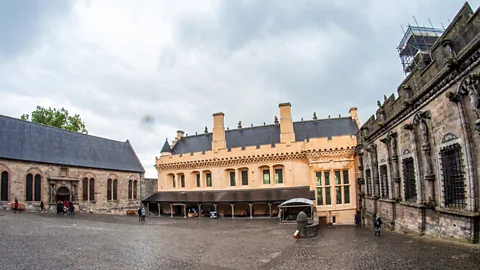 Amanda Ruggeri
Amanda RuggeriEven after King Robert the Bruce dismantled the castle’s defences to try to ensure the English would not take it again, Stirling Castle still did not disappear from the annals of history. After the Scottish Wars of Independence finally ended in the mid-14th Century, the first Stewart king, Robert II, began repairs to the castle.
Later Scottish monarchs continued to reshape the site for their own needs. One avid builder was King James III (1460-1488), who may have laid the groundwork for the Great Hall you can still see today.
It was James’ successors, though, who gave the castle its current look. Seeking to compete with contemporaries like England’s King Henry VII, King James IV built the King’s Old Building as his residence, along with the Great Hall, shown here. After a modern restoration of it was unveiled in 1999, the pale tangerine colour of the Great Hall, nicknamed ‘king’s gold’, was controversial – but it actually restores the shade of paint the hall would have had in the 1500s under James IV. (Credit: Amanda Ruggeri)
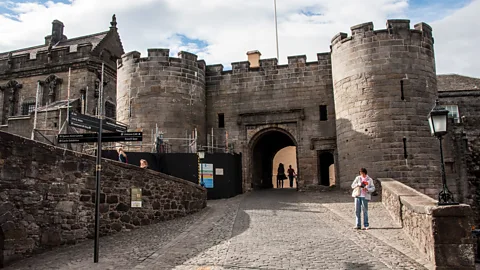 Amanda Ruggeri
Amanda RuggeriKing James IV also built this entrance – though it would have been even more impressive in his time when it was five storeys high.
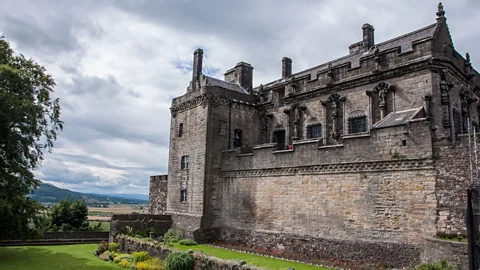 Amanda Ruggeri
Amanda RuggeriKing James V, who came to the throne at just one year old in 1513, later had his own construction scheme. He built the sumptuous palace, shown here, as a residence for him and his wife, French noblewoman Mary of Guise – the mother of Mary Queen of Scots. (Credit: Amanda Ruggeri)
 Amanda Ruggeri
Amanda RuggeriThe royal apartments still look as they may have in the 1540s; the Queen’s Lodgings are complete with Mary of Guise’s heraldic arms.
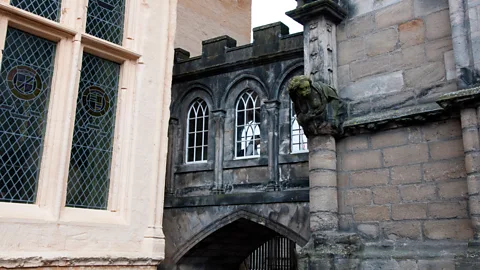 Amanda Ruggeri
Amanda RuggeriThe coronation ceremony for the infant Mary Queen of Scots took place at Stirling Castle in 1543, and this is where the pint-sized queen would spend her first few years of life. It also was where she would return to raise her own child, later crowned King James VI. This bridge, which still connects the Great Hall to Mary’s own chambers, was built on her request: it allowed her to more easily access the Great Hall to organise the infant prince’s baptism. (Credit: Amanda Ruggeri)
 Amanda Ruggeri
Amanda RuggeriToday, Stirling Castle remains a striking symbol of Scottish history – and one beloved by visitors from around the world.
